This post may contain affiliate links. Please read our disclosure policy.
If you’ve ever wondered how to roast butternut squash in the oven, you’re in the right place. When fall rolls around, there’s nothing more comforting than the rich, sweet taste of roasted butternut squash, and this tutorial will show you an easy, step-by-step method to get perfectly roasted halves every time. With just a few ingredients and minimal prep, this simple recipe for roasted butternut squash halves will quickly become a favorite in your kitchen.
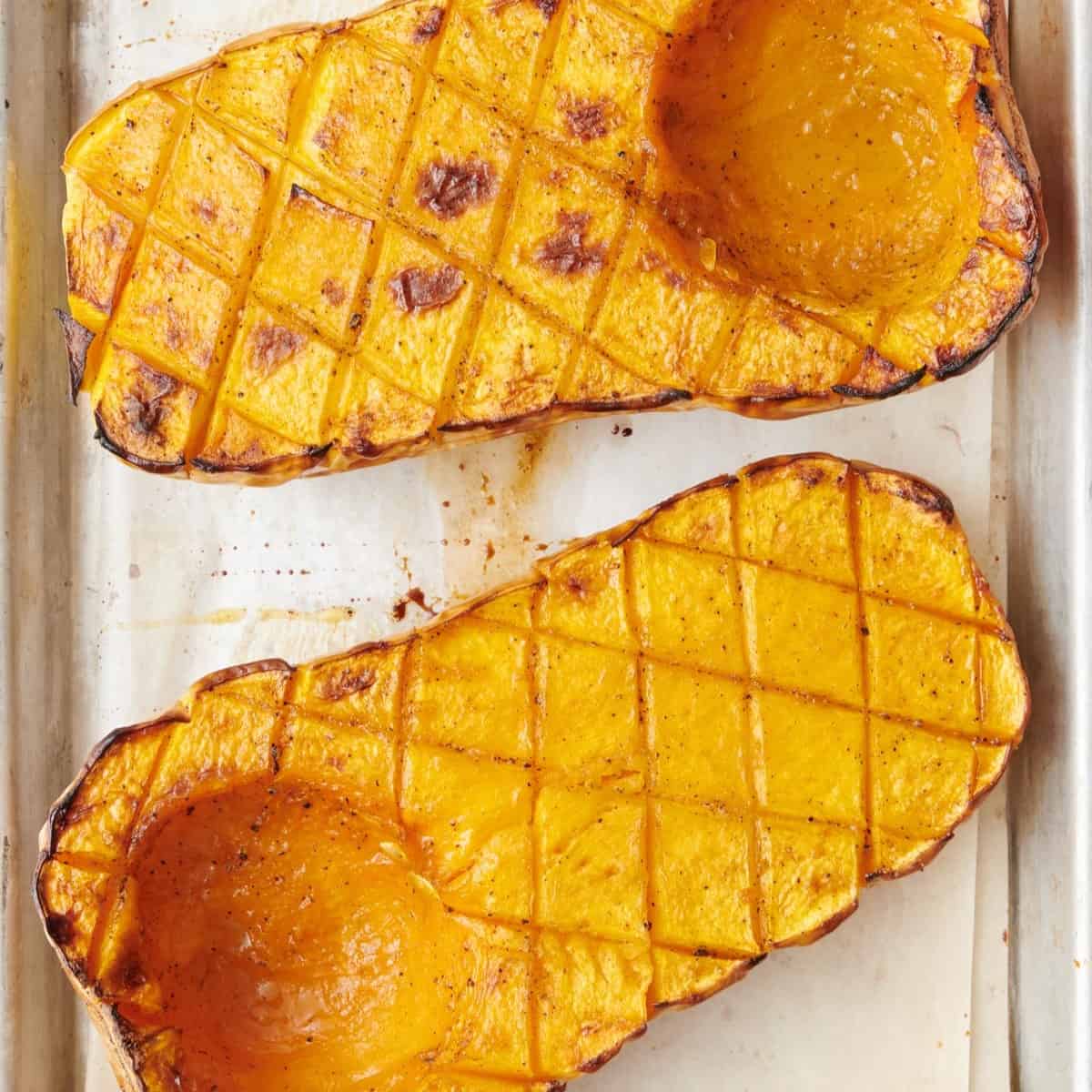
Table of Contents
- WHY LEARN HOW TO ROAST BUTTERNUT SQUASH IN THE OVEN
- INGREDIENTS TO MAKE ROASTED BUTTERNUT SQUASH
- HOW TO ROAST BUTTERNUT SQUASH
- TIPS FOR making the best ROASTED BUTTERNUT SQUASH HALVES
- recipes to make with these SIMPLE ROASTED BUTTERNUT SQUASH HALVES
- HOW TO REHEAT & STORE ROASTED BUTTERNUT SQUASH
- FREQUENTLY ASKED QUESTIONS
- MORE cooking tutorials:
- How to Roast Butternut Squash Halves Recipe
The secret to achieving perfectly roasted butternut squash halves is to treat them with a simple touch: a drizzle of olive oil, a sprinkle of salt and pepper, and, if you like, a touch of sweetness. Roasting butternut squash in the oven takes a somewhat intimidating vegetable and transforms it into a tender, sweet, and slightly caramelized side that could also stand as a dish on its own or become a stellar ingredient in other recipes.
WHY LEARN HOW TO ROAST BUTTERNUT SQUASH IN THE OVEN
- Seasonal nutrition. This winter squash is rich in essential nutrients like vitamins A and C, fiber, and potassium. And it’s the perfect addition to your fall and winter menu, bringing heartiness, flavor, and nutrition during the colder season.
- Use in a wide range of dishes. Butternut squash is so versatile. It can be enjoyed as is or included in savory soups and salads or sweet desserts. Learning how to roast butternut squash opens up a world of delicious options.
- Ease of preparation. This simple tutorial will show you how to roast butternut squash halves. With very minimal prep and a short ingredient list, mastering this basic kitchen skill is like a gift that keeps on giving.
- Delicious flavor and texture. Roasting brings out the natural sweetness of butternut squash and caramelizes its sugars, resulting in a rich flavor. It also strikes the perfect texture with tender creaminess on the inside and slightly crispy edges.
INGREDIENTS TO MAKE ROASTED BUTTERNUT SQUASH
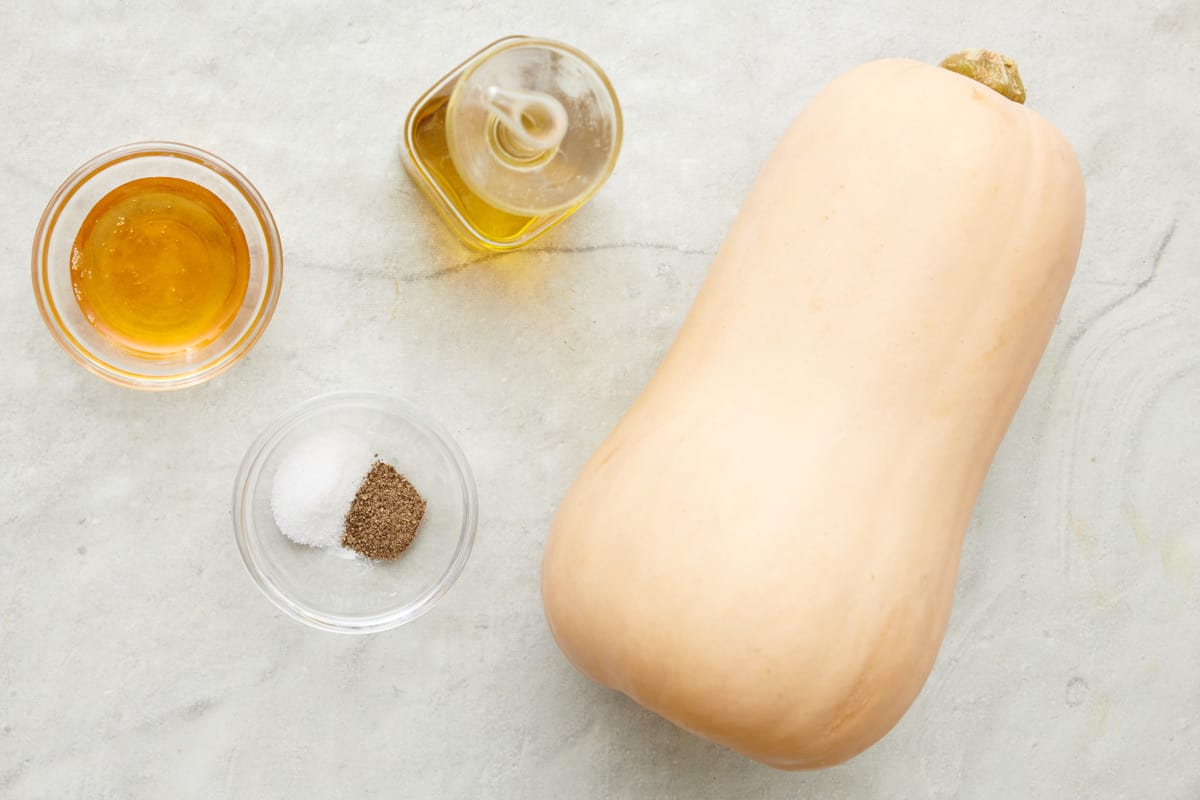
- Butternut squash: Smaller squash are typically sweeter and more tender, while larger ones are great because they yield lots of delicious flesh. I recommend going with medium to large-size butternut squash for this recipe.
- Olive oil: Used to coat the squash before roasting. Not only does adding oil add a subtle richness and flavor, but it also helps to caramelize the butternut squash.
- Salt and black pepper: These simple seasonings will enhance the overall flavor of the squash and add a slightly savory element.
- Honey: Though honey is optional, it adds a touch of sweetness and a wonderful contrast to the savory flavors, should you choose to use it.
HOW TO ROAST BUTTERNUT SQUASH
- Using a sharp knife, carefully cut off the stem and slice the squash in half lengthwise. Use a spoon to scoop out the seeds and stringy pulp from the center of each squash half. [Image 1]
- Use a sharp knife to make a few shallow diagonal cuts across the flesh of each squash half. [Image 2]
- Drizzle olive oil on top and season with salt and black pepper. [Image 3]
- Roast in the oven until the flesh becomes knife-tender and slightly caramelized. [Image 4]
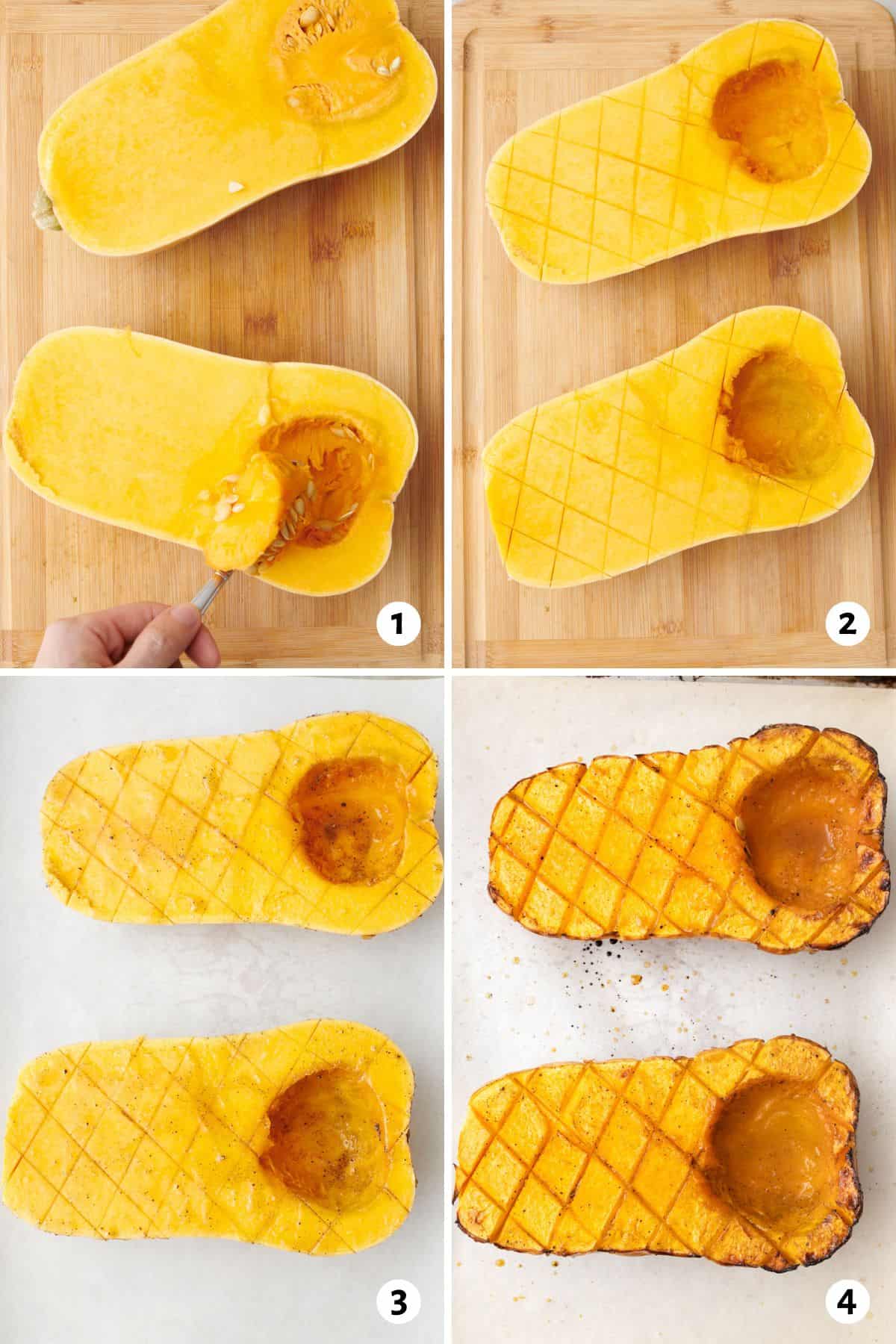
TIPS FOR making the best ROASTED BUTTERNUT SQUASH HALVES
- When buying a butternut squash, check for firmness and avoid squash that feels soft. A good squash should also feel heavy for its size when you lift it. That means it’s dense with ripe and flavorful flesh and has more flesh than seed.
- Use a sharp knife and a stable surface. Butternut squash can be tough to cut. Use a sharp chef’s knife and make sure your cutting board doesn’t swing around. To secure your cutting board, place a damp paper towel underneath it. The friction between the damp paper towel and the counter will prevent it from sliding around. Check out my complete guide on how to cut butternut squash.
- Use a scoop/spoon with a serrated edge to deseed. A grapefruit spoon or a melon baller can be helpful as they have serrated edges that can scrape out the insides.
- Roasting time varies depending on squash size. The best way to roast butternut squash is by keeping an eye on them and checking for tenderness with a knife. The squash should be fork-tender and slightly caramelized when done.
- If scooping out the flesh, do so while warm. It’s more manageable to work with it while it is still warm when the flesh easily separates from the skin.
recipes to make with these SIMPLE ROASTED BUTTERNUT SQUASH HALVES
- Roasted Butternut Squash Soup
- Creamy Butternut Squash Pasta
- Butternut Squash Risotto
- Butternut Squash Mac and Cheese
HOW TO REHEAT & STORE ROASTED BUTTERNUT SQUASH
Roasted butternut squash should be stored in an airtight container in the refrigerator.
To reheat, place the roasted butternut squash halves on a baking sheet and reheat them in the oven at 350°F for 10-15 minutes or until they are warmed through.
HOW LONG WILL cooked BUTTERNUT SQUASH LAST IN THE FRIDGE?
Roasted butternut squash will last up to 3 days in the fridge.
CAN I FREEZE cooked BUTTERNUT SQUASH?
Yes! You can freeze butternut squash halves. Allow them to cool to room temperature first then tightly wrap them in plastic wrap or aluminum foil and place in a freezer safe bag, making sure they are sealed well to prevent freezer burn. Freeze for up to 3 months. When ready to enjoy, thaw overnight in the refrigerator and reheat.
FREQUENTLY ASKED QUESTIONS
No! This easy roasted butternut squash halves recipe keeps the skin intact. It becomes tender when cooked and is much easier to remove after roasting. However, I recommend you wash and scrub the skin well before roasting.
Absolutely! You can flavor your butternut squash however you desire, depending on the recipe and your personal preferences. Consider sprinkling some pumpkin pie spice over the flesh for a seasonal treat. Or skip the honey and instead give it savory flavor with ranch seasoning, garlic powder, za’atar, lemon pepper seasoning, and Cajun seasoning.
The answer to this depends mostly on the recipe and your preference. Roasting butternut squash gives you a richer, more complex flavor. However, steaming the butternut squash as shown in this guide on how to cook butternut squash cubes yields fluffier, creamier texture, which is great in soups and baked goods.
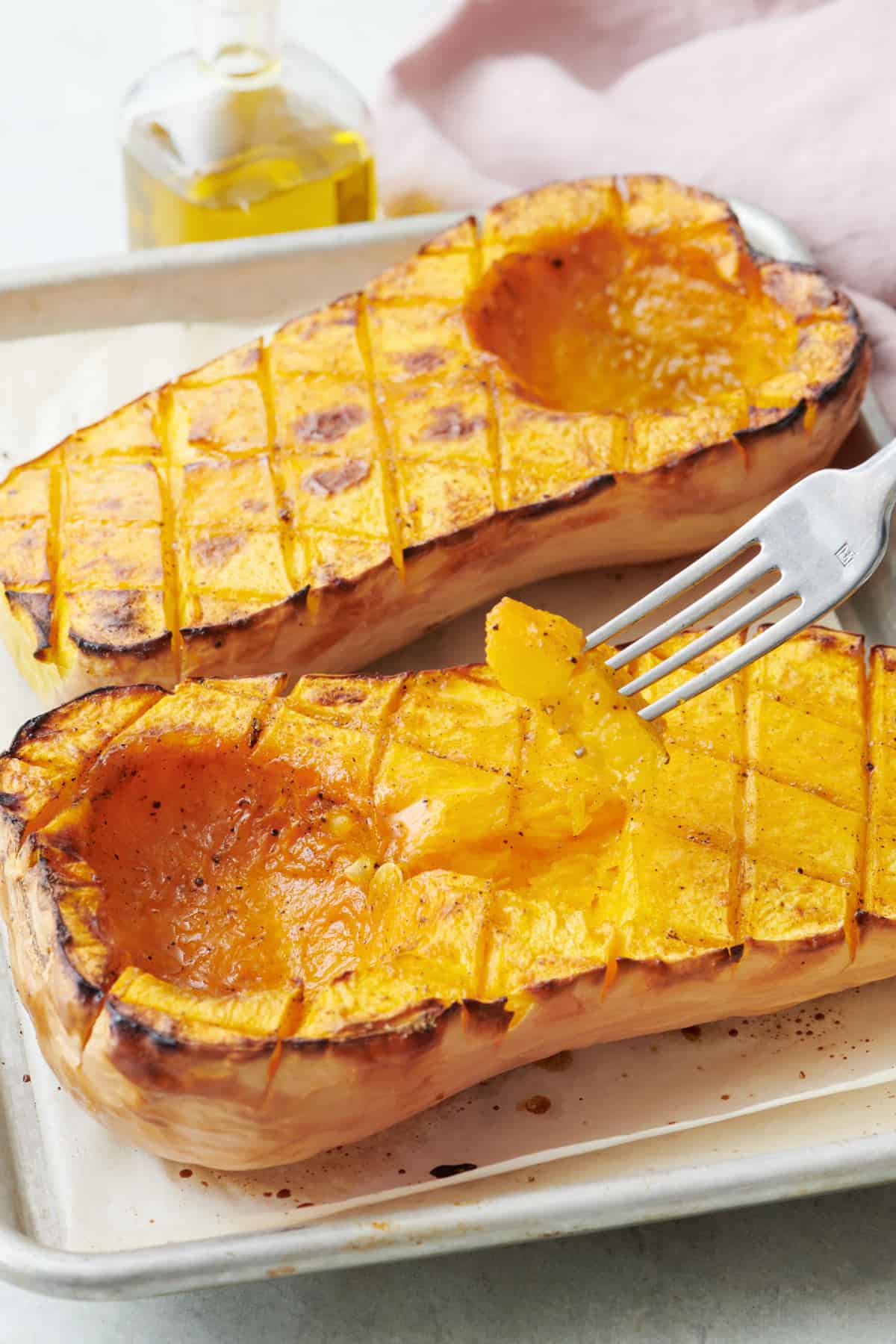
Now that you know how to roast butternut squash in the oven, the sky is the limit on how to serve it. You can drizzle some honey, grab a fork, and dig in for a satisfying treat! Or incorporate these into your favorite recipes, from hearty soups to salads, and more!
MORE cooking tutorials:
- How to Roast Vegetables
- How to Roast Red Peppers
- How to Roast Garlic
- How to Cook Butternut Squash Cubes
- How to Roast Acorn Squash Slices
- How to Cook Beets
- How to Make Pumpkin Puree
- How to Bake Sweet Potatoes
- How to Cook Spaghetti Squash
If you found this tutorial for How to Roast Butternut Squash helpful or if you try any recipe on Feel Good Foodie, then don’t forget to rate the recipe and leave a comment below! It helps others who are thinking of trying out this tutorial and we would love to hear about your experience. And if you snapped some shots, share it on Instagram so we can repost on Stories!
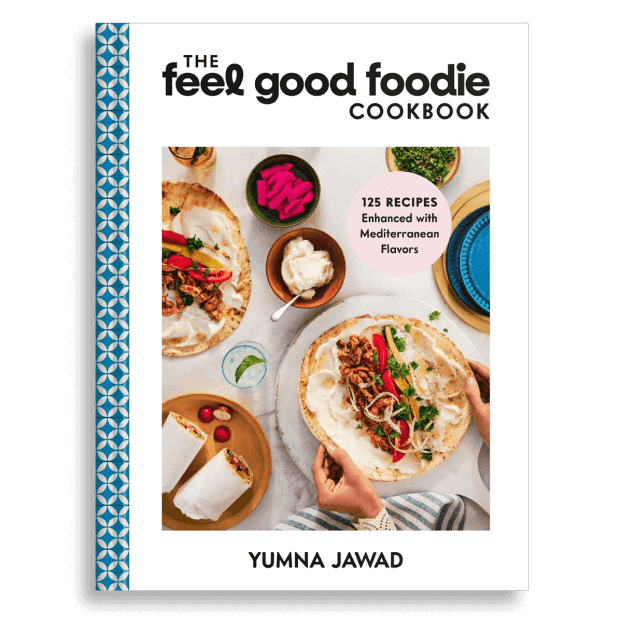
order MY book
The Feel Good Foodie Cookbook is now available everywhere books are sold!
Amazon TargetBarnes & Noble Books A Million Hudson Booksellers BookshopSCHULER Books

How to Roast Butternut Squash Halves
Ingredients
- 1 medium or large butternut squash
- 2 tablespoons olive oil
- 1 teaspoon salt
- ½ teaspoon black pepper
- 2 tablespoons honey optional
Instructions
- Preheat the oven to 425°F. Line a baking sheet with parchment paper.
- Using a sharp knife, carefully cut off the stem and slice the squash in half lengthwise. Use a spoon to scoop out the seeds and stringy pulp from the center of each squash half.
- Use a sharp knife to make a few shallow diagonal cuts across the flesh of each squash half. Then drizzle olive oil on top and season with salt and black pepper.
- Place the butternut squash halves on the prepared baking sheet, cut-side up.
- Roast in the oven until the flesh becomes knife tender and slightly caramelized, 45-55 minutes, depending on the thickness of the butternut squash.
- Cool for a few minutes. Then serve them as is or scoop out the flesh and use as desired.
Notes
Nutrition
Nutrition information provided is an estimate. It will vary based on cooking method and specific ingredients used.
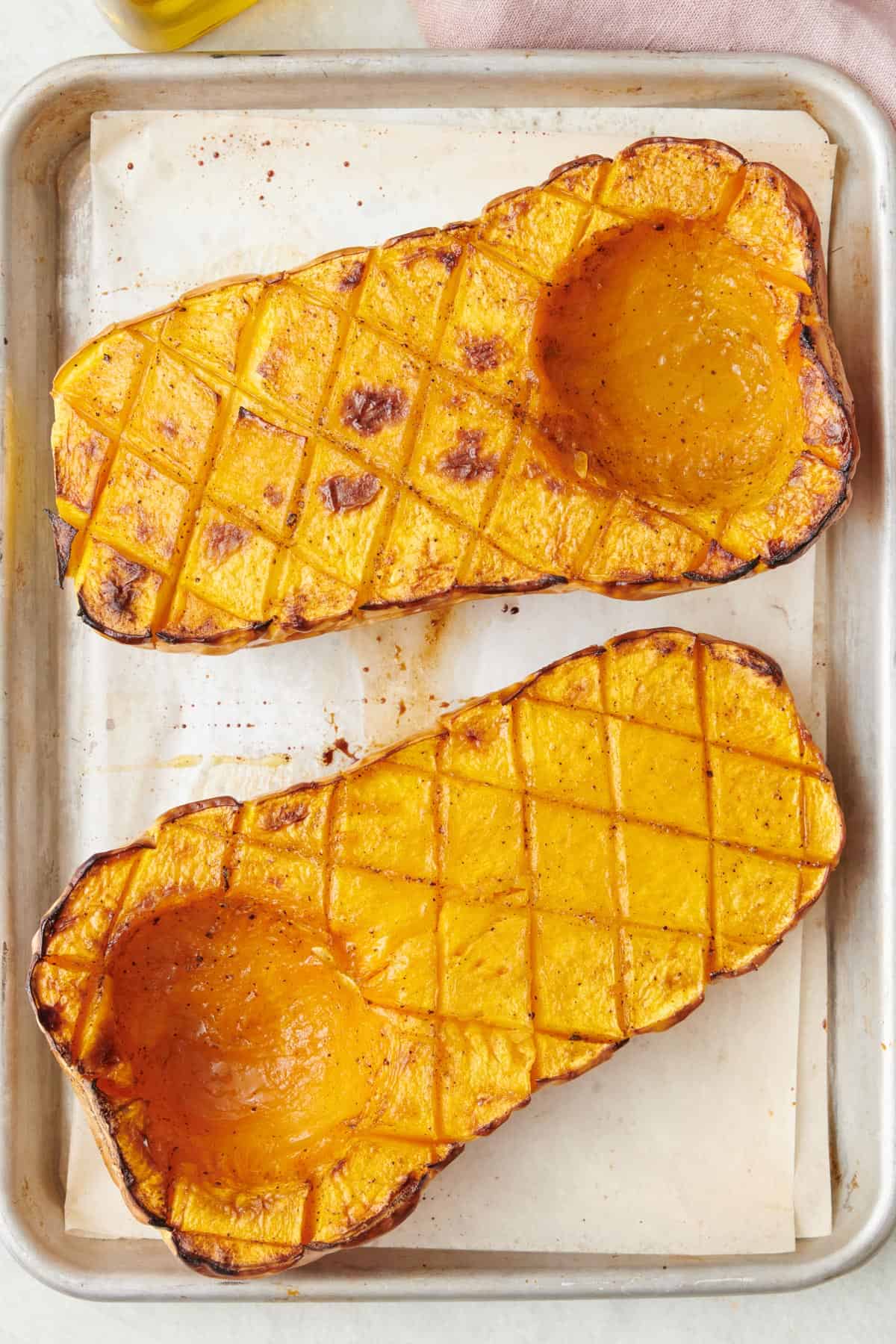






Glad I found this on google .
Glad you enjoyed it!